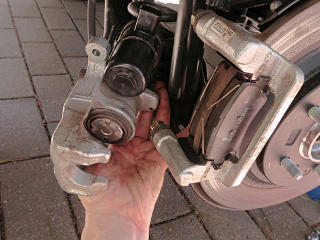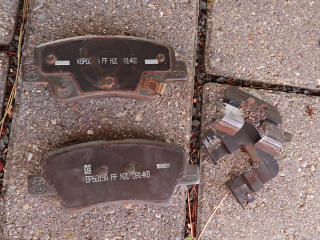
Note the little V-shaped springs across the edge of the pads. These simply insert into holes, and come right out. They're retained by the close presence of the caliper when it's installed.
|
Inspection of disk brakes is something that I try to do once a year, usually
as part of general cleaning-out a winter's worth of road salt abuse.
It is well known that hybrid and electric vehicles will seriously under-use
their service brakes due to regenerative braking, so it's easy to slip into
a mindset of not worrying about pad wear much at all.
That's valid, but there are other parts that can still present issues --
notably, the slide pins that the calipers float back and forth on, as well
as the little spring clips that keep the pads in place in the caliper frame
and help keep them from rattling around.
If the parts of the caliper cannot move freely, we can run into problems
like uneven pressure on either side of the disk, or a pad dragging.
It's also good to *use* the service brake fairly frequently, even if just a little bit, to move parts over their normal range and also to scrape off any accumulated rotor rust. Rotors are bare steel, and tend to begin sprouting rust when sitting in damp weather. The usual trick to defeat regeneration and use *only* the service brakes to slow down is to put the car in Neutral, do a nice smooth braking event, and then go back into normal Drive. The energy loss relative to an entire trip is negligible, so a friction braking event here and there isn't going to anger the Hypermiling Gods. For nitty-gritty details on brake calipers in general, refer to the first part of the Prius brake disassembly. This is just a quick overview of the equivalent on the Kona, notably on the rear wheels which have the weird electric parking brake actuators. So one difference is unplugging the connectors to those, but otherwise it's pretty much the same stuff. Other than making sure the parking brake is *un*set at car power-down, there doesn't seem to be any special procedure needed to disable the braking system, as the Kona doesn't do any automated pressurization checks after power-down like the Prius did. [In the end, as long as time was given to let the Prius system go quiescent, it wasn't really needed for that either.] This page is only exploration of the rear brakes, about a year after taking ownership of the (second!) Kona. About a year after *that* I finally got into the front ones, detailed in more depth in a second page. They were definitely due for a look by then. |

|
The inner and outer pads are clearly different, and have the anti-squeal shim plates integrally attached. |
_H* 220708, finalized 230526